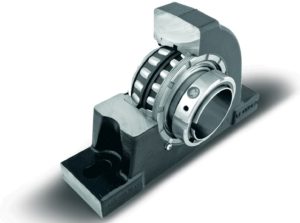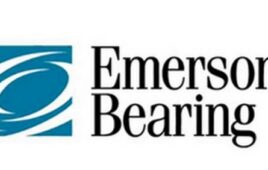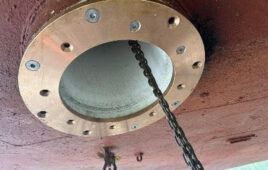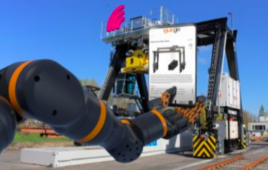
Ball bearings’ small areas of surface contact minimize friction-generated heat, so ball bearings work well in high-speed applications. Image courtesy igus
Bearings are internal machine components that are crucial to motion applications. They reduce friction between moving parts by giving a surface something on which to roll rather than slide. Rotary bearings consist of smooth rollers or metal balls and inner and outer surfaces (races) against which the rollers or balls travel. These rollers or balls carry load carrier and let axes spin freely. Bearings typically encounter radial and axial load. Radial loads are perpendicular to the shaft, and axial loads occur parallel to the shaft. Depending on the application, some bearings must withstand both loads simultaneously.
What’s the difference between ball and roller bearings?
Because the contact area between balls and races is so small, ball bearings excel in light to moderate loads. The small areas of surface contact also minimize friction-generated heat, so ball bearings work well in high-speed applications.
In contrast, roller bearings have cylindrical rollers. They’re common in applications such as conveyor belt rollers because their rolling elements make more surface contact with their races — so handle larger loads without deforming. Their shape also allows for a moderate amount of thrust load, as weight is distributed across cylinders instead of spheres.

Needle roller bearings are at the heart of cam followers such as these from Osborn. The compact design carries high loads.
What kinds of applications use needle roller bearings?
Needle-roller bearings operate in tight spaces — for example, in automotive applications such as rocker-arm pivots and transmissions. In short, these are roller bearings with rollers having a length at least four times the roller diameter. The large surface area of the needle roller bearing lets them support extremely high radial loads. Usually a cage orients and contains the needle rollers. The outer race is sometimes machined into the housing interior. Needle-roller bearings come in two different arrangements — a radial arrangement (in which the rollers run parallel to the shaft) and a thrust arrangement (in which the rollers are flat in a radial pattern and run perpendicular to the shaft).
What are thrust bearings?
Thrust roller bearings transmit load from one raceway to the other to resolve radial loads; their self-aligning capability makes them immune to shaft deflection and alignment errors. Thrust ball bearings go in applications with primarily axial loads and handle shaft misalignment. These bearings also work on high-speed axes in the aerospace and automotive industries.
Tapered roller bearings
Tapered roller bearings have tapered inner and outer ring raceways with tapered rollers between them — angled so the rollers’ surfaces converge at the bearing’s axis. These bearings are the only bearing type that can concurrently handle large amounts of axial and radial loads. Single-row taper bearings only support high axial loads from one direction.

Alignment is a critical element during the installation of rotary bearings. Making sure shaft alignment is checked can prevent problems before they start.
However, installations that put one tapered roller bearing against a second counteract additional load; this allows the bearings to support high radial and axial loads from multiple directions. Other caveats: Tapered roller bearings can only accommodate slight angular misalignment of the inner ring in relation to the outer ring — just a few minutes of arc at most. As with other roller bearings, tapered roller bearings must carry a minimum load, especially in high-speed applications where inertial forces and friction can damage rollers and raceways should they come out of contact.
How to pick the right lubricant for a rotary bearing?
Lubrication of bearings with rolling elements takes the form of oil or grease; grease usually lasts longer, thanks to thickeners that sustain a layer between raceways and rolling elements. Grease with extreme-pressure additives also extends bearing life under higher forces. Even so, oil is more common for open bearings or those subject to low torque or high speeds. Oil’s lower viscosity imparts less drag than greases as rollers move through the lubricant.
Mode of oil delivery, application rpm and temperature, and potential environmental contaminants dictate which oil is most suitable. Case in point: Operating temperature dictates which oil viscosity will work in a given application. Overly thick oil increases required torque to make the rotary bearing spin; overly thin oil won’t maintain the protective layer needed to prevent metal-on-metal contact.
Applications for rotary bearings
Bearings abound in industrial and consumer designs. For example, deep-groove ball bearings often go into in small to medium-sized electric motors because they can accommodate both high speeds and radial and axial loads. Self-aligning ball bearings, on the other hand, work well in fans. These bearings have two rows of balls with a common raceway in the outer ring. This design allows for angular misalignment while maintaining running accuracy. The only caveat is that they’re one of the most difficult bearings to install correctly.

Spherical roller bearings like these from Rexnord provide angular misalignment compensation, low friction, cool running temperatures, and high load capacity.
Tapered roller bearings go in needing support for axial and radial loads — as in a tire hub bearing vehicle weight and the axial loads associated with cornering. These bearings are also common in gearboxes where they mount with a second bearing of the same type in a face-to-face or back-to-back orientation. They provide rigid shaft support to minimize deflection. This reduced shaft deflection minimizes gear backlash. Tapered bearings also have the advantage of being lightweight but efficient, even while maintaining good overall speed capabilities. In applications where the bearings mount vertically, they typically mount in a face-to-face setup. In horizontal applications, they mount back-to-back.
Side note on Plain bearings
Plain bearings are cylindrical sleeves with an array of design elements to cater to specific applications. Some plain bearings go into applications requiring slide plates for straight strokes. Other plain bearings do the same job as roller-based thrust bearings, but use pads arranged in a circle around the cylinder. The pads create wedge-shaped regions of oil to prevent hard contact with the rotating disc supporting the application thrust.
Material innovations have made plastic plain bearings more useful than ever, though plain bearings of all types are lightweight and compact and can carry substantial load.
Growing use of plain plastic bearings and increasingly stringent industry standards means these bearings must often meet FDA, RoHS, and other standards. Some even meet EU directive 10/2011/EC standards, which holds material manufacturing processes to certain criteria.
Filed Under: Bearings, Bearing Tips





Tell Us What You Think!